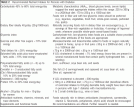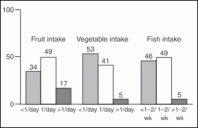Carbohydrate and Type 2 Diabetes - Medical Nutrition Treatment in the Management of Type 2 Diabetes
The recommended intake of carbohydrate for people with diabetes is 45% to 60% of total energy intake (Table 2). Provided that foods rich in fiber and with low-glycemic index predominate, there are no known deleterious effects with this range of carbohydrate intake.
When carbohydrate intakes are at the upper end of the proposed range, restriction of carbohydrate to around 45% of total energy and a partly replacement of carbohydrate by monounsaturated fat may be tried for some patients with unsatisfactory glycemic control.
However, there is concern that increased fat intake might promote weight gain and potentially contribute to insulin resistance. The advice for carbohydrate intake should therefore be individualized, based on nutrition assessment, metabolic results and treatment goals, however, there is no justification for the recommendation of very low-carbohydrate diets in persons with diabetes (8,43).
Vegetables, legumes, fresh fruit, and whole-grain cereal-derived foods are the preferred sources of carbohydrate. They are rich in fiber, micronutrients, and vitamins, and help to ensure the recommended intakes of other nutrients. However, many individuals with diabetes do not consume such foods on a regular basis (Fig. 2).
A number of factors influence glycemic response to carbohydrate-containing foods, including the nature of the starch (amylose, amylopectin, resistant starch), the amount of dietary fiber and the type of sugar. Different carbohydrates have different glycemic responses and, clearly, the amount of carbohydrate is one important factor in postprandial glucose levels.
However, foods with a low-glycemic index may confer benefits not only for postprandial glycemia in persons with type 2 diabetes, but also for their lipid profile (44 - 48).
Foods with a low-glycemic index (e.g., legumes, pasta, parboiled rice, whole-grain breads, oats, certain raw fruits) should therefore be substituted when possible for those with a high-glycemic index (e.g., mashed potatoes, white rice, white bread and rolls, sugary drinks).
People with diabetes should be encouraged to choose a variety of fiber-containing foods.
It has been shown that increased fiber intake results in benefits for glycemic control, hyperinsulinemia and serum lipids (49 - 51). Dietary fiber intake should ideally be more than 40 g/day, about half of which should be soluble, however, beneficial effects are also obtained with lower, and for some, more acceptable amounts (8). The available evidence from controlled clinical studies demonstrates that moderate intake of dietary sucrose in diets with an appreciable amount of fiber - with the sucrose displacing other fiber-depleted carbohydrate-containing food - does not worsen glycemic control in persons with diabetes (52 - 54).
 TABLE 2 Recommended Nutrient Intakes for Persons with Diabetes
TABLE 2 Recommended Nutrient Intakes for Persons with Diabetes
Thus, sucrose and other added sugars may be included in moderation in the diets of people with type 2 diabetes, however, the bulk of dietary carbohydrate should be derived from foods with a low-glycemic index and/or rich in fiber. It is of interest that low-glycemic index foods and fiber-rich foods appear to have an effect independent of other attributes; but many high-fiber foods do indeed have a low-glycemic index, and vice versa.
Fructose produces a reduction in postprandial glycemia when it replaces sucrose, however, this potential benefit is tempered by the fact that higher amounts of fructose may
 FIGURE 2 Frequency of fresh fruit, vegetable, and fish intake (n %) in a sample of 1988 persons with diabetes [930 male, 1058 female; mean age 57 - 13 years; mean diabetes duration 8 years] in Germany in 2000.
FIGURE 2 Frequency of fresh fruit, vegetable, and fish intake (n %) in a sample of 1988 persons with diabetes [930 male, 1058 female; mean age 57 - 13 years; mean diabetes duration 8 years] in Germany in 2000.
adversely effect plasma lipids by increasing triglycerides. But there is no reason to recommend that persons with diabetes avoid naturally occurring fructose, e.g., in fruits, vegetables and other foods. A moderate intake of fructose (up to 30 g/day) appears to have no deleterious effects on plasma insulin and lipids in persons with type 2 diabetes (8). Adding fructose, sugar alcohols, and other nutritive sweeteners, all of which are energy sources, does not have substantial advantage over added sucrose as a sweetener for people with diabetes and therefore should not to be encouraged (6,7,10). Intake of food containing sugar alcohols has been reported to cause diarrhea. Furthermore, it is unlikely that sugar alcohols in the amounts likely to be ingested in foods or meals will contribute to a significant reduction in total energy or carbohydrate intake, although they are only partially absorbed from the small intestine.
Approved nonnutritive sweeteners may be used by people with diabetes to sweeten beverages, desserts, fruits, etc. (6,14,55). The recommended acceptable daily intake (ADI), defined as the amount of a food additive that can be safely consumed on a daily basis over a person’s lifetime without risk, should be considered when nonnutritive sweeteners are chosen.
However, it is unknown whether the use of nonnutritive sweeteners improves glycemic control or assists in weight loss in persons with diabetes.
For individuals with type 2 diabetes treated with insulin, to avoid hypoglycemia and excessive postprandial hyperglycemia it is important that the timing and dose of insulin match the amount, type, and time of carbohydrate-containing food intake (8,9).
Individuals receiving intensive insulin therapy should adjust their premeal insulin dose based on the content and glycemic load of carbohydrate-containing snacks and meals. In persons with type 2 diabetes postprandial glucose responses to a variety of carbohydrates are similar if the amount of carbohydrate is constant (14). Patients should therefore try to be consistent in day-to-day carbohydrate intake when they are treated with fixed daily insulin doses or with high doses of sulfonylurea or glitinides to avoid hypoglycemic episodes. Self-monitoring of blood glucose is helpful in determining the most appropriate timing of food intake and optimal food choices for the individual patient. There are no general principles regarding the optimum frequency of snacks and meals. Individual preferences, the needs of different treatment regimes and total energy requirements are the main determinants of meal frequency and portion sizes (6).
Monika Toeller
German Diabetes Research Center, Heinrich-Heine University, Düsseldorf, Germany
Jim I. Mann
Department of Human Nutrition, University of Otago, Dunedin, New Zealand